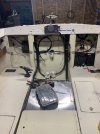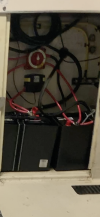You are using an out of date browser. It may not display this or other websites correctly.
You should upgrade or use an alternative browser.
You should upgrade or use an alternative browser.
Fuse at Battery Terminals
- Thread starter Red Monster
- Start date
23Hourston
Well-Known Member
Derby
Crew Member
Does anyone run fuses between the battery and the Perko switch? I saw these and wondered what others do: https://www.amazon.ca/gp/product/B0019ZBTV4/ref=ox_sc_act_title_4?smid=A3DWYIK6Y9EEQB&psc=1
I have one for my starting battery & another for my other bank of battery's.. Make sure u carry a spare fuse for them and clean them yearly with lots Dielectric grease on them.. They need the be corrision free if not u can and will run in a battery re charging properly problem
YachtMech
Well-Known Member
I use those all the time, they even make fuse bus bars for them now. they are a great product.Does anyone run fuses between the battery and the Perko switch? I saw these and wondered what others do: https://www.amazon.ca/gp/product/B0019ZBTV4/ref=ox_sc_act_title_4?smid=A3DWYIK6Y9EEQB&psc=1
the only cuircuit you dont need to put a fuse on is between the battery->switch->engine starter motor, but everything else needs a fuse. if its not a start battery the fuse can be at the battery or it can be after the switch.
BSS summerized the ABYC reg here http://assets.bluesea.com/files/resources/reference/2010_ABYCexcerpts.pdf
Red Monster
Well-Known Member
I use those all the time, they even make fuse bus bars for them now. they are a great product.
the only cuircuit you dont need to put a fuse on is between the battery->switch->engine starter motor, but everything else needs a fuse. if its not a start battery the fuse can be at the battery or it can be after the switch.
BSS summerized the ABYC reg here http://assets.bluesea.com/files/resources/reference/2010_ABYCexcerpts.pdf
The link states "Note that wire intended to carry engine starting currents between the batteries, the switch, and the starter, is not required to have main circuit protection devices installed." I assume this applies if the starter alone is wired to the starter battery and everything else is wired to the house battery? My boat did not come wired that way. Should it be?
Last edited:
YachtMech
Well-Known Member
that means it doesnt have to have a fuse, or breaker,between the battery and starter motor, but should be wired to a switch, so you can isolate it in case you have a starter runaway. so for example you can have a sheilded wire run up the to switch, then have the starter suppy wire run off the other side of the switch without a fuse, and you can connect other loads to the same supply but they have to be fused beyond the switch.The link states "Note that wire intended to carry engine starting currents between the batteries, the switch, and the starter, is not required to have main circuit protection devices installed." I assume this applies if the starter alone is wired to the starter battery and everything else is wired to the house battery? My boat did not come wired that way. Should it be?
jim morrow
Active Member
I rewired my 1980 boat myself. Back in 1997 without any Blue Seas gear. Had two batteries, a Perko battery switch and battery isolator for charging the 2 batts. I used #2 welding cables for the battery runs. I made a small copper buss bar into negative terminal strip at the transom, and there were some small bus bars under my dashboard. I had a lot more circuits than original wiring.( 12 to18 negative wires to the negative buss bar.)
All wires were crimped and sealed if possible, and spray painted with Glypthal non metallic paint, including the buss bar.
Later a surveyor told me that I needed better support for the batteries, a plastic strap over the batts was considered inadequate...
I never did have a large fuse at the supply batts., but a great safety idea. carry spares...
The use of AC fuses in a DC circuit can and will end in a fire as the AC fuses will not interrupt the current! Buy the expensive DC fuse.
All wires were crimped and sealed if possible, and spray painted with Glypthal non metallic paint, including the buss bar.
Later a surveyor told me that I needed better support for the batteries, a plastic strap over the batts was considered inadequate...
I never did have a large fuse at the supply batts., but a great safety idea. carry spares...
The use of AC fuses in a DC circuit can and will end in a fire as the AC fuses will not interrupt the current! Buy the expensive DC fuse.
YachtMech
Well-Known Member
lol your the second person that mentioned using welding cable... dont use welding cable, it is not rated for marine use due to fire protection and water intrusion ratings. regardless of blue sea systems begin around or not, marine bus bars have been around and readily available for decades, and I would advise against making your own bus bars. There are redily available set standards by the ABYC for battery retention and terminal protection, as well as wiring grades, sheilding and fuse protection.I rewired my 1980 boat myself. Back in 1997 without any Blue Seas gear. Had two batteries, a Perko battery switch and battery isolator for charging the 2 batts. I used #2 welding cables for the battery runs. I made a small copper buss bar into negative terminal strip at the transom, and there were some small bus bars under my dashboard. I had a lot more circuits than original wiring.( 12 to18 negative wires to the negative buss bar.)
All wires were crimped and sealed if possible, and spray painted with Glypthal non metallic paint, including the buss bar.
Later a surveyor told me that I needed better support for the batteries, a plastic strap over the batts was considered inadequate...
I never did have a large fuse at the supply batts., but a great safety idea. carry spares...
The use of AC fuses in a DC circuit can and will end in a fire as the AC fuses will not interrupt the current! Buy the expensive DC fuse.
YachtMech
Well-Known Member
I think you may have missunderstood Jeff or are slightly miss-stating what he said, you dont need protection (other than a switch) from the battery to the starter on the stating battery, however anything else coming off that battery needs circuit protection, and same with anything attached to the starter termial post, which is why when the engine power feed comes off the starter to the wiring harness it goes to a breaker usually on the engine. Quite often other things are wired to the start battery they all need protection, its just the direct path to the starter that doesnt.Just did this no fuses needed on acr if wires under 8 inches only a fuse on house battery. not required on starter battery, as per Jeff cote from pacific yachting
also you do need fuses on that ACR, Im not sure what "under 8 inch" rule you are following, ABYC rules below and Blue seas installation instructions outlining fuse requirements attached, none of them exempt a circuit from protction.
Considerations for DC Main Circuit Protection
11.10.1.1.1. OVERCURRENT PROTECTION DEVICE LOCATION: Undergrounded conductors shall be provided with overcurrent protection within a distance of seven inches (175 mm) of the point at which the conductor is connected to the source of power measured along the conductor.
11.6.1.2.1. A battery switch shall be installed in the positive conductor(s) from each battery or battery bank with a CCA rating greater than 800 Amperes.
11.6.1.2.3. BATTERY SWITCH RATINGS: The intermittent rating of a battery switch shall not be less than the maximum cranking current of the largest engine cranking motor that it serves. The minimum continuous rating of a battery switch shall be the total of the ampacities of the main overcurrent protection devices connected to the battery switch, or the ampacity of the feeder cable to the switch, whichever is less.
and futher
each ungrounded conductor connected to a battery, battery charger, alternator, or other charging source, shall be provided with overcurrent protection within a distance of seven inches (175mm) of the point of connection to the DC electrical system or to the battery. There are exceptions to this seven-inch rule.
If the conductor is connected to a source of power other than a battery terminal and is contained throughout its entire distance in a sheath or enclosure such as a conduit, junction box, control box, or enclosed panel, the overcurrent protection shall be placed as close as practicable to the point of connection to the source of power, but not to exceed 40 inches (1.02m).
If the conductor is connected directly to a battery and is contained throughout its entire distance in a sheath or enclosure such as a conduit, junction box, control box, or enclosed panel, the overcurrent protection shall be placed as close as practicable to the battery, but not to exceed 72 inches (1.83m).
Overcurrent protection is not required in conductors from self-limiting alternators with integral regulators if the conductor is less than 40 inches long (1.02m), is connected to a source of power other than the battery, and is contained throughout its entire distance in a sheath or enclosure.
Attachments
Last edited:
Similar threads
- Replies
- 20
- Views
- 2K



